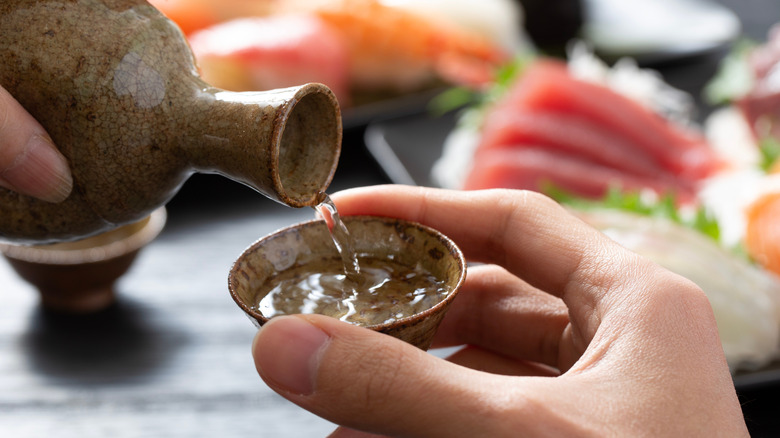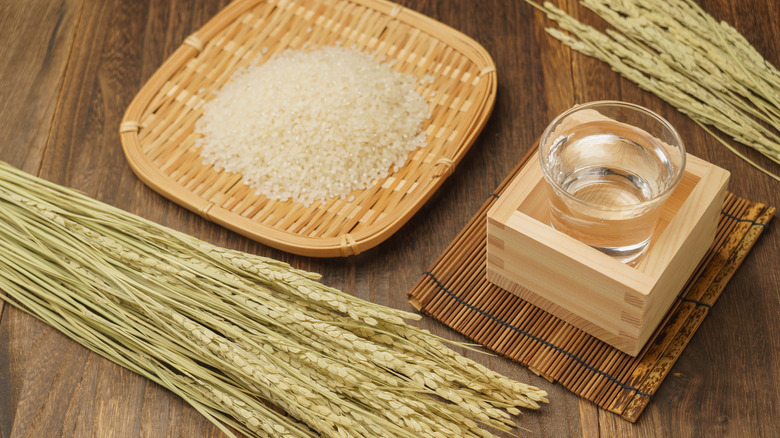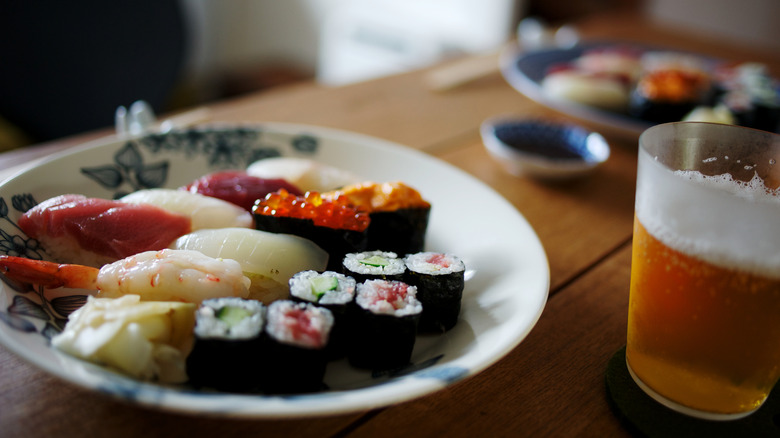Why Sake And Sushi Pair So Well Together
Go into any sushi restaurant and you'll see sake, served either hot or cold, listed on the menu. Some are fruity and sweet, while others are dry and crisp, and there's a type of sake to pair with any sushi roll or sashimi. Chowhound spoke with Jeni Van Nortwick, Head of Trade at Sake ONO, to understand why this food and beverage pairing works so well.
These products are of course both from Japan and rice-based (sushi rolls, at least), but the pairing harmony goes beyond that. As Van Nortwick explains, "I like to think of this in two different ways, the first being the old adage, 'if it grows together, it goes together.' Alcoholic beverages have been cultivated over time to pair with cuisines in the region in which they are developed." Makes sense — we see this also with cheese and wine. If producing a beverage, it's logical to pair it alongside whatever foods are already present in the region. Take coastal California: Chardonnay produced there is buttery and rich, which naturally pairs with buttery and rich California lobster found in the ocean of that region.
Using whatever ingredients are most abundant in a region is also logical, and Van Nortwick points out, "quite often, these foods and beverages share a certain sort of terroir that intentionally complement each other." Japan has 12 sake production regions – as is done with wine — and within these areas, it's typically required to use local water and Japanese rice.
The science behind pairing sake and sushi
If you're a true food nerd, know there is a science behind the harmony of this pairing. As Van Nortwick explains, "there is also a scientific factor as well — sake is high in amino acids, which highlights the umami flavor in seafood." Breaking this down even further, this occurrence is due to the glutamic acid compound in sake, which is the amino acid in rice protein. Seafood contains an inosinic acid compound, which is what provides the umami. These two compounds react, and result in a stronger umami flavor.
According to Van Nortwick, there is a bit more science to understand here. "Sake is also low in iron by nature and therefore does not react with the fats in fish, lowering the perception of any 'fishy' flavors," she explains. Alcoholic beverages with higher levels of sulfur dioxide can also enhance the undesirable fishy scents and taste.
Know that within the umbrella of sake and sushi pairing, there are more precise combinations to complement specific flavors. A slightly sweet Junmai Gingo sake can be served with a California Roll, while a chilled, complex and refined, Junmai Daiginjo is best with sashimi.
Not the traditional pairing in Japan
For the same reason we would consider sake and sushi to be an ideal pairing — both are made from rice — means it may not be a good pairing. In fact, this combo is not traditionally served together in Japan, its country of origin. This is because rice is typically not eaten alongside alcohol – so sashimi and sake would be more normal, but not a roll.
You'll see sake on any sushi menu in the U.S., but this is more of a western concept. Enjoying something that is not traditional is not necessarily a bad thing, though. As previously mentioned, certain types of sakes are better than others when set against rice-forward dishes, so you can make it work. The sake that pairs with the most variety of sushi and sashimi is a crisp and dry Junmai Ginjoshu.
In Japan, it would be more common to have wine, beer, or tea alongside sushi and drink sake beforehand. If you want to eat sushi in a more traditional manner, know that it's common to start with a beer as the first drink. Japan has some delicious, crisp lagers like Asahi and Sapporo, which are both easy to find in American sushi restaurants. For wine, Riesling or light reds are a solid choice to complement the seafood and rice.
And if you're not pairing sake with other cuisines, you're making a huge mistake. Like wines, different sakes have different flavor profiles, meaning it can be paired with just about anything. If you know the profile of the bottle you have or the glass you're ordering, it's easy to find the perfect culinary match.


